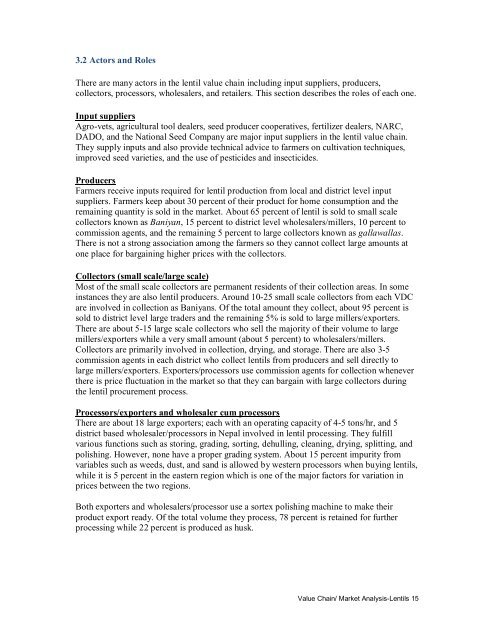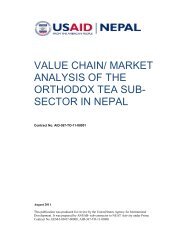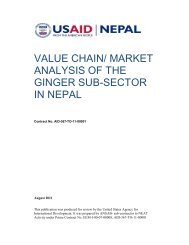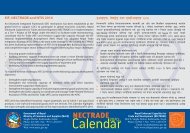value chain/ market analysis of the lentil sub-sector in ... - Nepal Trade
value chain/ market analysis of the lentil sub-sector in ... - Nepal Trade
value chain/ market analysis of the lentil sub-sector in ... - Nepal Trade
You also want an ePaper? Increase the reach of your titles
YUMPU automatically turns print PDFs into web optimized ePapers that Google loves.
3.2 Actors and Roles<br />
There are many actors <strong>in</strong> <strong>the</strong> <strong>lentil</strong> <strong>value</strong> <strong>cha<strong>in</strong></strong> <strong>in</strong>clud<strong>in</strong>g <strong>in</strong>put suppliers, producers,<br />
collectors, processors, wholesalers, and retailers. This section describes <strong>the</strong> roles <strong>of</strong> each one.<br />
Input suppliers<br />
Agro-vets, agricultural tool dealers, seed producer cooperatives, fertilizer dealers, NARC,<br />
DADO, and <strong>the</strong> National Seed Company are major <strong>in</strong>put suppliers <strong>in</strong> <strong>the</strong> <strong>lentil</strong> <strong>value</strong> <strong>cha<strong>in</strong></strong>.<br />
They supply <strong>in</strong>puts and also provide technical advice to farmers on cultivation techniques,<br />
improved seed varieties, and <strong>the</strong> use <strong>of</strong> pesticides and <strong>in</strong>secticides.<br />
Producers<br />
Farmers receive <strong>in</strong>puts required for <strong>lentil</strong> production from local and district level <strong>in</strong>put<br />
suppliers. Farmers keep about 30 percent <strong>of</strong> <strong>the</strong>ir product for home consumption and <strong>the</strong><br />
rema<strong>in</strong><strong>in</strong>g quantity is sold <strong>in</strong> <strong>the</strong> <strong>market</strong>. About 65 percent <strong>of</strong> <strong>lentil</strong> is sold to small scale<br />
collectors known as Baniyan, 15 percent to district level wholesalers/millers, 10 percent to<br />
commission agents, and <strong>the</strong> rema<strong>in</strong><strong>in</strong>g 5 percent to large collectors known as gallawallas.<br />
There is not a strong association among <strong>the</strong> farmers so <strong>the</strong>y cannot collect large amounts at<br />
one place for barga<strong>in</strong><strong>in</strong>g higher prices with <strong>the</strong> collectors.<br />
Collectors (small scale/large scale)<br />
Most <strong>of</strong> <strong>the</strong> small scale collectors are permanent residents <strong>of</strong> <strong>the</strong>ir collection areas. In some<br />
<strong>in</strong>stances <strong>the</strong>y are also <strong>lentil</strong> producers. Around 10-25 small scale collectors from each VDC<br />
are <strong>in</strong>volved <strong>in</strong> collection as Baniyans. Of <strong>the</strong> total amount <strong>the</strong>y collect, about 95 percent is<br />
sold to district level large traders and <strong>the</strong> rema<strong>in</strong><strong>in</strong>g 5% is sold to large millers/exporters.<br />
There are about 5-15 large scale collectors who sell <strong>the</strong> majority <strong>of</strong> <strong>the</strong>ir volume to large<br />
millers/exporters while a very small amount (about 5 percent) to wholesalers/millers.<br />
Collectors are primarily <strong>in</strong>volved <strong>in</strong> collection, dry<strong>in</strong>g, and storage. There are also 3-5<br />
commission agents <strong>in</strong> each district who collect <strong>lentil</strong>s from producers and sell directly to<br />
large millers/exporters. Exporters/processors use commission agents for collection whenever<br />
<strong>the</strong>re is price fluctuation <strong>in</strong> <strong>the</strong> <strong>market</strong> so that <strong>the</strong>y can barga<strong>in</strong> with large collectors dur<strong>in</strong>g<br />
<strong>the</strong> <strong>lentil</strong> procurement process.<br />
Processors/exporters and wholesaler cum processors<br />
There are about 18 large exporters; each with an operat<strong>in</strong>g capacity <strong>of</strong> 4-5 tons/hr, and 5<br />
district based wholesaler/processors <strong>in</strong> <strong>Nepal</strong> <strong>in</strong>volved <strong>in</strong> <strong>lentil</strong> process<strong>in</strong>g. They fulfill<br />
various functions such as stor<strong>in</strong>g, grad<strong>in</strong>g, sort<strong>in</strong>g, dehull<strong>in</strong>g, clean<strong>in</strong>g, dry<strong>in</strong>g, splitt<strong>in</strong>g, and<br />
polish<strong>in</strong>g. However, none have a proper grad<strong>in</strong>g system. About 15 percent impurity from<br />
variables such as weeds, dust, and sand is allowed by western processors when buy<strong>in</strong>g <strong>lentil</strong>s,<br />
while it is 5 percent <strong>in</strong> <strong>the</strong> eastern region which is one <strong>of</strong> <strong>the</strong> major factors for variation <strong>in</strong><br />
prices between <strong>the</strong> two regions.<br />
Both exporters and wholesalers/processor use a sortex polish<strong>in</strong>g mach<strong>in</strong>e to make <strong>the</strong>ir<br />
product export ready. Of <strong>the</strong> total volume <strong>the</strong>y process, 78 percent is reta<strong>in</strong>ed for fur<strong>the</strong>r<br />
process<strong>in</strong>g while 22 percent is produced as husk.<br />
Value Cha<strong>in</strong>/ Market Analysis-Lentils 15






